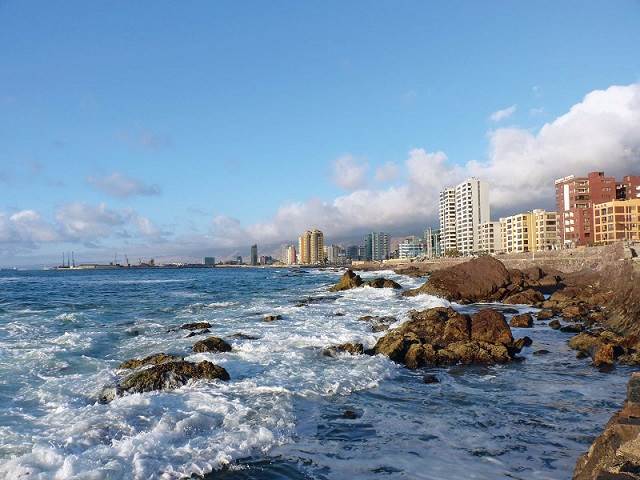This premier mining port in Northern Chile has grown exponentially in recent years. A modern city and business hub, set along a desert coastline with beautiful rock formations in the sea.
Antofagasta is a city with a long history. Its first inhabitants for thousands of years were the Chango Indians, who gave today’s regional capital its name: “Gateway of the Sun” or Antofagasti. The name was actually given to the Natural Monument, a rock formation that is the de rigueur image on post cards of Antofagasta – “La Portada” – a great rock that sea erosion has given the shape of an arch.
It is a great tourist attraction, though by no means the only one. There are several things to observe in this city, which in the last ten years has experienced great progress, most visibly in its modern port. Antofagasta is Chile’s most important mining city. Its port receives the production of all the mineral extraction activity in the region, which has been increasing and in turn fostering the city’s rapid growth, reflected in new buildings and modern commercial centers.
If you’d like to see the traditional city, you should go to the main square, Plaza de Armas, which is surrounded by old buildings. Or visit the market and help yourself to a meal of ceviche with oysters. (Ceviche is a dish of raw white fish or seafood marinated in lemon juice and chopped onions and serves as an appetizer.) An enjoyable outing is to walk along the renovated seaside drive that covers a distance of about one kilometer, which has recovered the city’s important and beautiful seaside promenade.
Main Attractions
Beaches
The best beaches are in the north, especially the celebrated La Portada Beach and beautiful Hornitos Beach, with quiet waters ideal for bathing, fine sands, and where you can find razor clams and other shellfish with the rudimentary technique of your toes. Mejillones Bay is ideal for fishing, snorkeling and undersea fishing. In this part of the country it is important to take certain precautions to protect yourself from the heat and the sun’s rays, such as using sunblock. The tides are dangerous and we recommend following lifeguards’ instructions.
The Regional Museum
Located in the historic district, one block away from the main square and displaying its proud façade, is the old Customs House. It houses a huge collection of minerals, and historical and cultural exhibits. You will see over 9,000 splendidly exhibited pieces.
The Huanchaca Ruins
The vestiges of this old silver mine (dating back to 1892) are located on Avenida Argentina, Antofagasta. Its architecture is striking because of its thick walls of reddish-colored rock. In its day it was the most modern refinery in Latin America. Each December a Christmas Concert is held here with choir singing, a performance by Antofagasta’s symphonic orchestra, and fireworks.
La mano del desierto
Many people are taken aback by the sight of a hand, 11 meters tall (36 ft), rising from the sand and seemingly greeting them. It was sculpted from granite by Chilean artist Mario Irarrázabal and located at a height of 1,100 meters (3,609 ft), 75 km (46.6 mi) south of Antofagasta. You can’t miss this photo opportunity!
Cerro Paranal Observatory
This cutting-edge observatory is located 120 km (74.5 mi) south of Antofagasta. Cerro Paranal is one of the most important observatories in the world, equipped with a VLT (Very Large Telescope) that consists of four Unit telescopes, with main mirrors 8.2 m in diameter (26.9 ft). The observatory is operated by ESO (European Southern Observatory). This astronomy complex is located 2,600 m (8,530 ft) above sea level, on the summit of Paranal Mountain. It is open to visitors on weekends, to take advantage of the practically unique conditions of Chile’s skies.


